- Animal production leads in terms of number of establishments
The preliminary results of the 2014 Annual Survey of Philippine Business and Industry (ASPBI) showed that the country had a total of 1,160 agriculture, forestry and fishing establishments with total employment (TE) of 20 and over.
Among the industries, animal production led the sector with 365 establishments, accounting for 31.5 percent of the total number of establishments. This was followed by growing of non-perennial and perennial crops with 308 establishments (26.6%) and 206 establishments (17.8%), respectively.
The remaining 24.2 percent (281 establishments) of the total were engaged in the following:
- Fishing, 128 establishments (11.0%)
- Support activities to agriculture and post-harvest crop activities, 98 establishments (8.4%)
- Aquaculture, 49 establishments (4.2%)
- Silviculture and other forestry activities, logging, and support services to forestry, 6 establishments (0.5%)
Figure 1 displays the percentage distribution of agriculture, forestry and fishing establishments with TE of 20 and over by industry group in 2014.

At the regional level, Western Visayas recorded the highest number of establishments at 268 or 23.1 percent of the total. Davao Region followed with 174 establishments (15.0%). Other regions with more than a hundred number of establishments are:
- Central Luzon, 131 establishments (11.3%)
- Northern Mindanao, 129 establishments (11.1%)
- CALABARZON, 119 establishments (10.3%)
Figure 2 shows the distribution of agriculture, forestry and fishing establishments with TE of 20 and over by region in 2014.
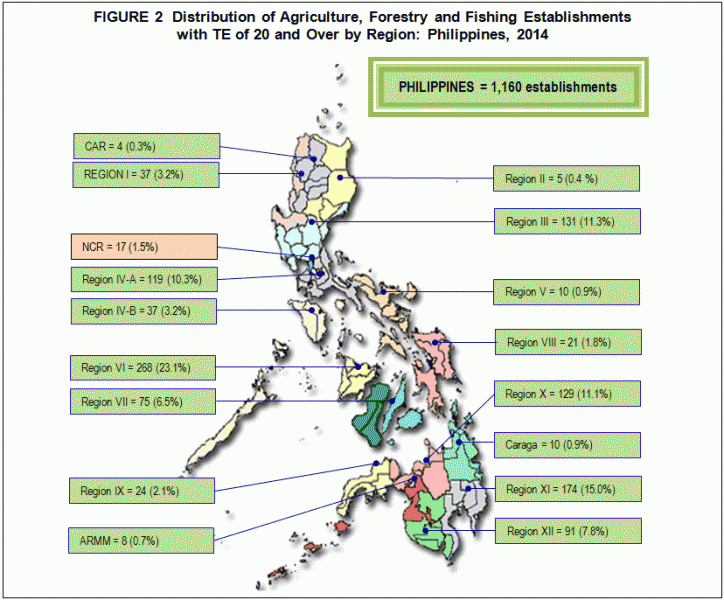
- Growing of perennial crops generates the highest employment
Total employment generated by agriculture, forestry and fishing establishments with TE of 20 and over reached 147,128 in 2014. Of the total workforce, 145,059 workers or 98.6 percent were paid employees while the remaining 1.4 percent were working owners and unpaid workers.
Among industry groups, growing of perennial crops employed the most number of workers with 66,638 or 45.3 percent of the total. Growing of non-perennial crops ranked second with 34,030 workers (23.1%) while animal production ranked third with 18,771 workers (12.8%).
Figure 3 shows the distribution of employment for agriculture, forestry and fishing establishments with TE of 20 and over by industry group in 2014.
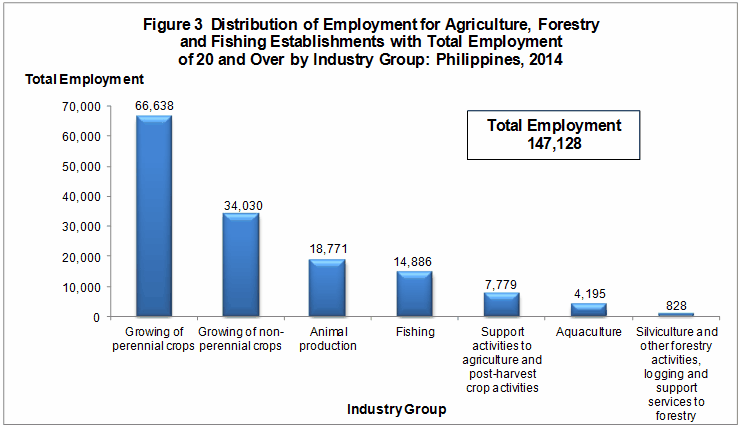
At the regional level, Davao Region ranked second in terms of the number of establishment. It emerged as the largest employment generator with 39,412 workers or 26.8 percent of the total. Western Visayas came in next with 25,208 workers (17.1%), followed by SOCCSKSARGEN with 19,248 workers (13.1%).
The average number of workers per establishment for the sector was recorded at 127. Among industries, growing of perennial crops posted the highest average with 323 workers, followed by silviculture and other forestry activities, logging, and support services to forestry with 138 workers
- Support activities to agriculture and post-harvest crop activities industry pay the highest average annual compensation
Total compensation paid by the sector to its employees in 2014 amounted to PHP25.0 billion, translating to an average annual compensation of PHP172,498 per employee.
Among industries, establishments engaged in growing of perennial crops spent the highest compensation of PHP13.8 billion, comprising more than half (55.1%) of the total. Growing of non-perennial crops followed as far second with PHP2.8 billion (11.0%). Support activities to agriculture and post harvest crop activities ranked third with PHP2.7 billion (10.8%).
Support activities to agriculture and post-harvest crop activities paid an average annual compensation of PHP348,062 per employee. Other industries paying an average annual compensation of more than a hundred thousand are:
- Growing of perennial crops, PHP210,537 per employee
- Fishing, PHP178,596 per employee
- Aquaculture, PHP148,393 per employee
- Animal production, PHP133,052 per employee
- Silviculture and other forestry activities, logging and support services to forestry, PHP115,725 per employee
Figure 4 shows the average annual compensation of employees for agriculture, forestry and fishing establishments with total employment of 20 and over by industry group in 2014.
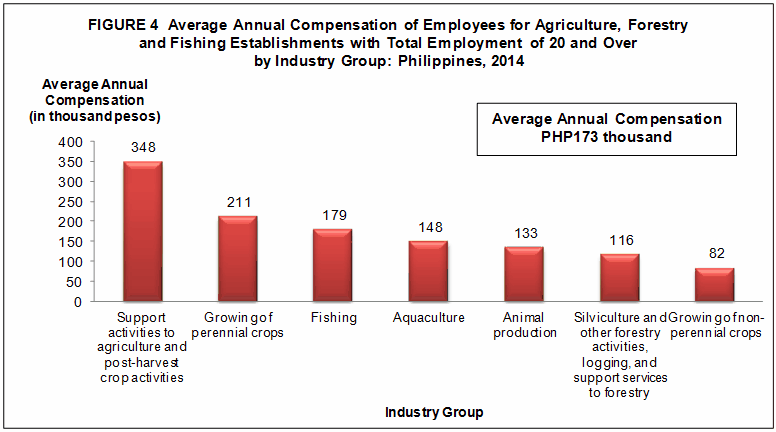
At the regional level, National Capital Region (NCR) paid the highest average annual compensation of PHP356,723 per employee. CARAGA and Northern Mindanao followed with average annual compensation of PHP267,866 and PHP223,489, respectively. On the other hand, Eastern Visayas paid, the lowest average annual compensation of PHP52,025 per employee.
- Growing of perennial crops industry generates almost half of the total value of output
Total value of output generated by agriculture, forestry and fishing establishments with TE of 20 and over reached PHP137.9 billion in 2014.
By industry, growing of perennial crops generated PHP59.9 billion or 43.4 percent of the total value of output. This was followed by animal production and fishing with respective shares of 29.0 percent (PHP40.1 billion) and 9.9 percent (PHP13.7 billion).
Figure 5 illustrates the percentage distribution of value of output for agriculture, forestry and fishing establishments with total employment of 20 and over by industry group in 2014.
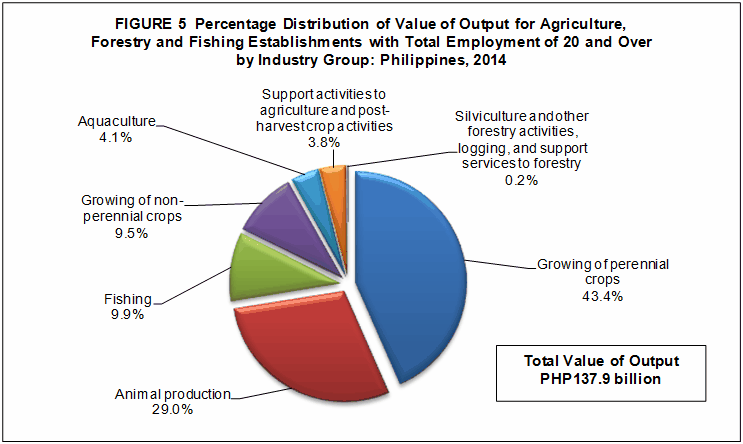
The top three regions in terms of value of output are all located in Mindanao with a combined value of output of 62.4 percent of the total. Davao Region generated the highest value of output with PHP36.6 billion or 26.5 percent, followed by Northern Mindanao and SOCCSKSARGEN with respective shares of 18.8 percent (PHP25.9 billion) and 17.1 percent (PHP23.6 billion).
- Growing of perennial crops industry incurs the highest expense
Total expense, including compensation, for agriculture, forestry and fishing establishments with TE of 20 and over amounted to PHP134.8 billion.
Among industries, growing of perennial crops incurred the highest expense amounting to PHP59.5 billion or 44.2 percent. Animal production ranked second with PHP36.5 billion (27.1%), followed by fishing with PHP14.4 billion (10.7%).
The top three regions in terms of value of output were also the top regions in terms of value of expense, with combined shares of 61.8 percent of the total. Davao expended PHP35.6 billion (26.4%), Northern Mindanao with PHP24.9 billion (18.5%) and SOCCSKSARGEN with PHP22.7 billion (16.8%).
- Income per expense ratio stands at 1.04
The sector generated an income per expense ratio of 1.04 in 2014. This means that for every peso spent, a corresponding income of PHP1.04 was generated.
Among industries, growing of non-perennial crops recorded the highest income per expense ratio of 1.21 while support activities to agriculture and post-harvest crop activities posted the lowest ratio of 0.76.
The income per expense ratio of five other industries are as follows:
- Animal production, 1.07
- Fishing, 1.04
- Growing of perennial crops, 1.03
- Aquaculture, 1.02
- Silviculture and other forestry activities, logging and support services to forestry, 0.99
- Growing of perennial crops generates the highest value added
Total value added produced by establishments with TE of 20 and over in 2014 was estimated at PHP38.1 billion.
Growing of perennial crops generated the highest value added amounting to PHP18.4 billion or almost half (48.2%) of the total value added. This was followed by animal production and growing of non-perennial crops with respective value added of PHP6.8 billion (17.7%) and PHP5.8 billion (15.3%).
At the regional level, Davao Region recorded the highest share to value added of 28.5 percent of the total or PHP10.9 billion, followed by SOCCSKSARGEN with 17.9 percent (PHP6.8 billion) and Northern Mindanao with 17.1 percent (PHP6.5 billion).
Regions which contributed less than one percent to total value added are:
- ARMM, 0.9 percent
- Eastern Visayas, 0.6 percent
- Cagayan Valley, 0.2 percent
- Cordillera Administrative Region, 0.2 percent
- Bicol Region, 0.1 percent
- Aquaculture industry posts the highest productivity
The ratio of value added to employment, a measure of labor productivity, was recorded at PHP259,272 per worker in 2014.
Aquaculture activities generated a labor productivity of PHP402,579 per worker, the highest among industries. Animal production ranked second with PHP359,605 per worker while fishing activities came in next with PHP280,247 per worker.
Figure 6 displays the labor productivity for agriculture, forestry and fishing establishments with total employment of 20 and over by industry group in 2014.
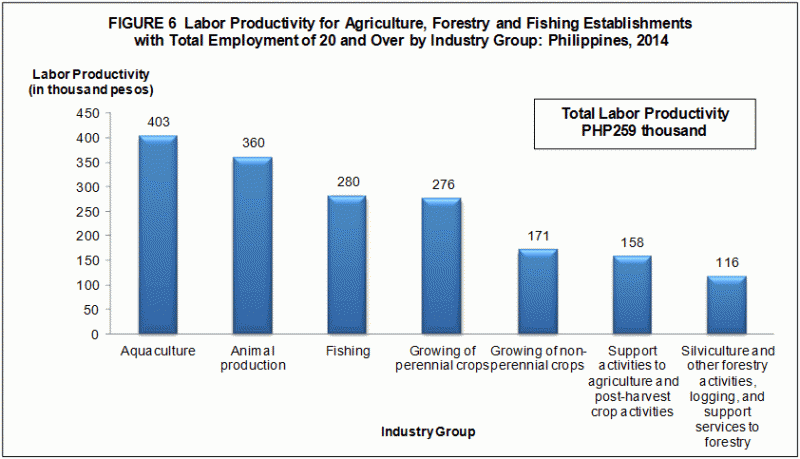
Central Luzon was the most labor productive region in 2014, registering a ratio of PHP691,415. This was followed by CAR and CARAGA with respective labor productivity of PHP668,047 and PHP407,065 per worker.
- Gross addition to tangible fixed assets reaches PHP7.6 billion
Gross addition to tangible fixed assets acquired by agriculture, forestry and fishing establishments was valued at PHP7.6 billion in 2014.
Among industries, animal production contributed the highest gross addition to tangible fixed assets at PHP2.4 billion or 31.7 percent of the total. This was followed closely by growing of perennial crops with PHP2.3 billion or 31.0 percent worth of gross addition to fixed assets.
Across the country, SOCCSKSARGEN led all regions in terms of gross addition to tangible fixed assets estimated at PHP1.7 billion or 22.2 percent share to total. Central Luzon and Davao Region followed with PHP1.5 billion (20.0%) and PHP 1.1 billion (14.2%), respectively.
- Total subsidies received in 2014 amounts to PHP3.2 billion
Subsidies granted by the government to support the business operation of agriculture, forestry and fishing establishments with TE of 20 and over in 2014 amounted to PHP3.2 billion.
Establishments engaged in support activities to agriculture and post-harvest crop activities located in NCR were the only recipient of subsidies in 2014.
TECHNICAL NOTES
- Introduction
This Special Release presents the preliminary results of the 2014 ASPBI for the agriculture, forestry and fishing establishments with total employment of 20 and over.
The 2014 ASPBI is one of the designated statistical activities of the Philippine Statistics Authority (PSA). Data collected from the survey provide information on the levels, structure, performance, and trends of economic activities of the formal sector in the entire country for the year 2014. The 2014 Survey of Tourism Establishments in the Philippines was undertaken as a rider to this survey.
The survey was conducted nationwide in April 2015 with the year 2014 as the reference period of data, except for employment which is as of November 15, 2014.
Data are presented at the national and industry group or 3-digit 2009 Philippine Standard Industrial Classification (PSIC) and at the regional level.
- Legal Authority
TThe conduct of the 2014 ASPBI is authorized under Republic Act 10625 known as the Philippine Statistical Act of 2013 - Reorganizing and strengthening of the Philippine Statistical System (PSS), its agencies and instrumentalities.
- Scope and Coverage
The 2014 ASPBI covered establishments engaged in 18 economic sectors classified under the 2009 PSIC, namely:
Agriculture, Forestry and Fishing (A)
Mining and Quarrying (B)
Manufacturing (C)
Electricity, Gas, Steam, and Air Conditioning Supply (D)
Water Supply; Sewerage, Waste Management and Remediation Activities (E)
Construction (F)
Wholesale and Retail Trade; Repair of Motor Vehicles and Motorcycles (G)
Transportation and Storage (H)
Accommodation and Food Service Activities (I)
Information and Communication (J)
Financial and Insurance Activities (K)
Real Estate Activities (L)
Professional, Scientific and Technical Activities (M)
Administrative and Support Service Activities (N)
Education (P)
Human Health and Social Activities (Q)
Arts, Entertainment and Recreation (R)
Other Service Activities (S)
The following sections of the 2009 PSIC are excluded from the scope of this survey and all other establishment-based surveys of PSA:
- Public Administration and Defense; Compulsory Social Security (Section O)
- Activities of Households as Employers; Undifferentiated Goods and Services Producing Activities of Households for Own Use (Section T)
- Activities of Extra-territorial Organization and Bodies (Section U)
The survey was confined to the formal sector of the economy, which consists of the following:
- Corporations and partnership
- Cooperatives and foundations
- Single proprietorship with employment of 10 and over
- Single proprietorships with branches
Hence, the 2014 ASPBI covered only the following economic units:
All establishments with total employment of 10 and over; and
All establishments with total employment of less than 10, except those with Legal Organization = 1 (Single proprietorship) and Economic Organization = 1 (Single establishments), that are engaged in economic activities described according to the 2009 PSIC
- Frame
The frame for the 2014 ASPBI was extracted from the 2014 List of Establishments (LE). The estimated number of establishments in operation in the country in 2014 totaled to 944,500. About 266,257 establishments (28.0% of the total establishments) belong to the formal sector of which 231,241 (87.0%) comprised the establishment frame. This frame was used to draw the sample establishments for the survey.
- Unit of Enumeration
The unit of enumeration for the 2014 ASPBI is the establishment. An establishment is defined as an economic unit under a single ownership or control which engages in one or predominantly one kind of activity at a single fixed location.
- Classification of Establishments
An establishment is categorized by its economic organization, legal organization, industrial classification, employment size, and geographic location.
Economic Organization relates to the organizational structure or role of the establishment in the organization. An establishment may be single establishment, branch, establishment and main office with branches elsewhere, main office only, and ancillary unit other than main office.
Legal Organization refers to the legal form of the economic entity that owns the establishment. This provides the legal basis for ownership. An establishment may be single proprietorship, partnership, government corporation, stock corporation, non-stock corporation, and cooperative.
Industrial classification of an economic unit was determined by the activity from which it derives its major income or revenue. The 2009 PSIC was utilized to classify economic units according to their economic activities.
Size of an establishment is determined by its total employment (TE) as of a specific date.
Geographic Classification refers to the classification of establishments by geographic area using the Philippine Standard Geographic Code (PSGC) classification.
- Methodology
Sampling Design
The survey utilized stratified systematic sampling with 5-digit PSIC serving as the industry strata and employment size as the second stratification variable.
For establishments with TE of 20 and over, the 17 administrative regions serve as the geographic domains while the 5-digit level (sub-class) of the 2009 PSIC serves as the industry domain.
Estimation Procedure
a. Non-Certainty Stratum (strata TE of 20-49 and TE of 50-99)
The estimate of the total of a characteristic ![]() for the non-certainty employment strata in TE of 20 and over for an industry domain in each region (geographic domain) is
for the non-certainty employment strata in TE of 20 and over for an industry domain in each region (geographic domain) is

where:
s denotes the non-certainty employment strata in TE of 20 and over
p = 1, 2,..., 17 regions (geographic domains)
xspj = value of the jth establishment in the non-certainty employment strata in TE of 20 and over for an industry domain in each region
j = 1, 2, 3,…, nsp establishments
Wspj = weight of the jth establishment in the non-certainty employment strata in TE of 20 and over for an industry domain in each region

Nsp = total number of establishments in the non-certainty employment strata in TE of 20 and over for an industry domain in each region
nsp = number of sample establishments in the non-certainty employment strata in TE of 20 and over for an industry domain in each region
b. Certainty Stratum
The estimate of the total of a characteristic ![]() for the certainty employment stratum in TE of 20 and over in an industry domain in each geographic domain (region) is
for the certainty employment stratum in TE of 20 and over in an industry domain in each geographic domain (region) is

where:
c denotes the certainty employment stratum in TE of 20 and over
p = 1, 2,..., 17 regions (geographic domains)
xcpj = value of the jth establishment in the certainty employment stratum in TE of 20 and over in an industry domain within each region
J = 1, 2, 3, …, mcp establishments
mcp = number of establishments in the certainty employment stratum in TE of 20 and over in an industry domain within each region
c. Total Estimate for TE of 20 and Over
The estimate of the total of a characteristic ![]() for the industry domain in each region (geographic domain) was obtained by aggregating the estimates for all employment strata (non-certainty and certainty) in the same industry domain,
for the industry domain in each region (geographic domain) was obtained by aggregating the estimates for all employment strata (non-certainty and certainty) in the same industry domain,

where
dp denotes the industry domains in each region
National level estimates of the characteristics by industry domain were obtained by aggregating separately the estimates  for the particular industry domain from all the regions.
for the particular industry domain from all the regions.
Weight Adjustment Factor for Non-Response
To account for non-response in the non-certainty strata, the adjustment factors, and (n/n’) was multiplied with the sampling weight (W) of each of the sampling unit. The sampling weight which is defined as N/n was recomputed as

For the non-certainty employment stratum in TE of 20-49 or 50-99, the adjusted weight (W’spj) is

where:
- Response Rate
Response rate for Agriculture, Forestry and Fishing Sector for establishments with TE of 20 and over was 76.9 percent (648 out of 843 establishments). This included receipts of "good" questionnaires, partially accomplished questionnaires, reports of closed, moved out or out of scope establishments.
Reports of the remaining non-reporting establishments were imputed based on established imputation methods and from other available administrative data sources. However, reports of establishments which were found to be duplicates and out of business in 2014, were not imputed.
Of the total responses, 7 establishments responded online.
- Limitation of Data
The 2014 ASPBI covered only the formal sector of the economy.
- Concepts and Definitions of Terms
Economic Activity is the establishment’s source of income. If the establishment is engaged in several activities, its main economic activity is that which earns the biggest income or revenue.
Total employment is the number of persons who worked in for the establishment as of November 15, 2014.
Paid employees are all full-time and part-time employees working in or for the establishment and receiving pay, as well as those working away from the establishment and paid by and under the control of the establishment. Included also are all employees on sick or maternity leave, paid vacation or holiday and on strike. Excluded are directors paid solely for their attendance at meetings, consultants, workers on indefinite leave, working owners who do not receive regular pay, home workers and 98 workers receiving pure commissions only.
Compensation is the sum of salaries and wages, separation, terminal pay and gratuities paid by the establishment to its employees and total employer’s contribution to SSS/GSIS, ECC, PhilHealth, PAG-IBIG etc.
Salaries and wages are payments in cash or in kind to all employees, prior to deductions for employee’s contributions to SSS/GSIS, withholding tax, etc. Included are total basic pay, overtime pay and other benefits.
Income or Revenue includes cash received and receivables for goods/products and by-products sold and services rendered. Valuation is at producer prices (ex-establishment) net of discounts, and allowances, including duties and taxes but excluding subsidies.
E-Commerce refers to the selling of products or services over electronic systems such as the Internet Protocol-based networks and other computer networks, Electronic Data Interchange (EDI) network, or other on-line system. Excluded are orders received from telephone, facsimile and e-mails
Expense refers to cost incurred by the establishment in an enterprise’s effort to generate revenue, representing the cost of doing business. This is treated on a consumed basis. It excludes cost incurred in the acquisition of income generating assets.
Intermediate expense are expenditures incurred in the production of goods such as materials and supplies used, fuels, lubricants, oils and greases used; electricity and water purchased, agricultural/forestry/fishery and industrial services done by others.
Value added is gross output less intermediate input. Gross output is value of output plus income from non-industrial services done for others (except rent income from land). Intermediate input is intermediate expense plus expense for non-industrial services done by others (except rent expense for land) and all other expense.
Value of output represents the sum of the sale of products and by-products, income from industrial services done for others, sale of goods less cost of goods sold, fixed assets produced on own account, and change in inventories of finished products and work-in-progress.
Gross addition to tangible fixed assets is equal to capital expenditures less sale of fixed assets, including land.
Change in Inventories is computed as the value of ending inventory less the beginning inventory.
Inventories refer to the stock of goods owned by and under the control of the establishment as of a fixed date, regardless of where the stocks are located. Valuation is at current replacement cost in purchaser prices. Replacement cost is the cost of an item in terms of its present price rather than its original cost.
Subsidies refer to special grants received from the government in the form of financial assistance or tax exemption or tax privilege to aid and develop an industry.
